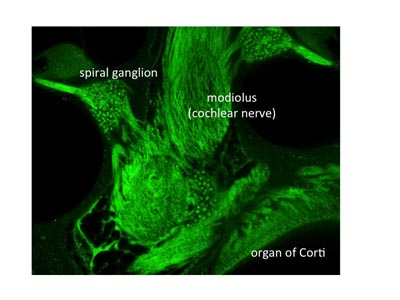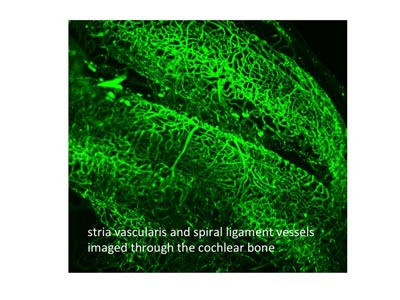Director: Robert V. Harrison
The Auditory Science Laboratory has been part of The Hospital for Sick Children (SickKids) and the University of Toronto (Department of Otolaryngology – Head and Neck Surgery) for over 30 years. We employ a wide range of research techniques to explore the structure and function of the normal and pathological inner ear and the development of the auditory brain. Our methods include brain imaging and electrophysiological techniques, including the recording of single neurons from different areas of the auditory brain. We also carry out evoked potential and otoacoustic emission research in human subjects and in animal models. In our anatomical studies, we make histological evaluations of the inner ear with light and electron microscopy and we also probe neural activity patterns in the auditory brain with immunolabeling techniques. In recent years we have mastered corrosion cast studies of vascular structures in the inner ear and also of the trachea and larynx.
A new research initiative this past year has been an investigation of the damage to cochlear capillary networks (e.g. stria vascularis) resulting from cytomegalovirus (CMV) infection. This work is part of the PhD thesis work done by Mattia Carraro, and our project is in collaboration with Albert Park at the University of Utah. Carraro was recognized for his work by winning our annual Raymond Ng Award.
Carraro has also introduced some novel imaging techniques, including laser thin sheet microscopy, and has refined the method to allow whole cochlear specimens (mouse) to be viewed in detail without bone removal. In the examples shown below individual spiral ganglion cells, cochlear vasculature can easily be recognized.
A recent major achievement for one of our graduate students, Lisa D’Alessandro, was the completion and final defense of her PhD thesis on the developmental plasticity of the auditory midbrain. Congratulations to Lisa. This past year has also been productive for our project manager Jaina Negandhi. She has been working on projects ranging from recording ABRs in animal models, studying midbrain activity patterns with c-fos labeling, and investigating audiometric data in children with auditory neuropathy.
This past year, through the funding with a CIHR team grant, we have had useful collaborations with other research teams including that of Dr. Lu-Yang Wang at SickKids and Dr. Vincent Lin at Sunnybrook Health Sciences Centre. In addition to basic laboratory research we have active collaboration with the SickKids cochlear implant team including Drs. Blake Papsin, Karen Gordon and Adrian James. The research funding climate in Canada has become rather unsettled to say the least. Federal funding from CIHR is very competitive. We are pleased to report that we have a new five-year research project funded by CIHR to study inhibitory and excitatory neural interactions during auditory brain development.
In this last year, our research has resulted in publication of eight peer-reviewed papers, as well as contributions to the latest edition (6th) of Cummings Otolaryngology: Head and Neck Surgery. Harrison has also co-authored a book entitled: “Understanding the Evidence: Wind Turbine Noise. The expert panel on wind turbine noise and human health”.
As a result of hard work by our trainees and staff, the Auditory Science Laboratory has had a very productive year. Thank you all for your contributions.


